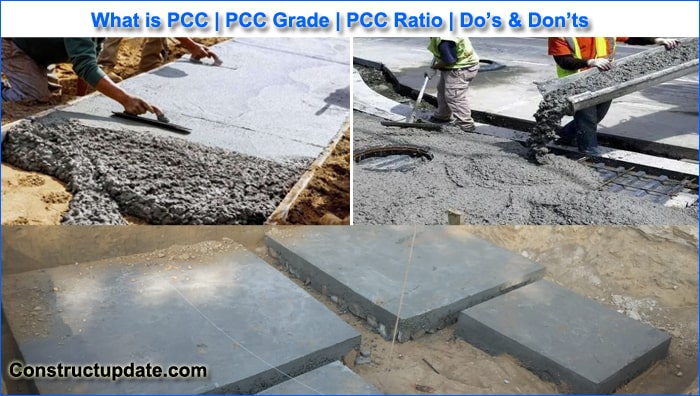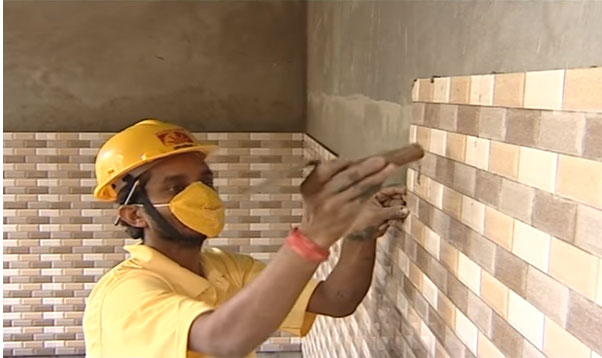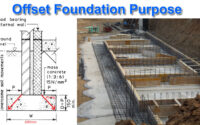What is PCC in Construction | Plain Cement Concrete PCC Methods | PCC Materials and Curing Method
What is PCC?
PCC is an abbreviation for plain cement concrete. A combination of cement, fine aggregate (sand), and coarse aggregate are known as “plain cement concrete” (PCC). PCC is completed before beginning any R.C.C. or masonry work directly on the excavated soil in order to create a level surface, prevent concrete from being placed directly on the soil to avoid combining with it and weakening it, and create a level surface.
In this post, we examine the PCC installation process, dos and don’ts, and benefits of PCC installation.
Before beginning any RCC or masonry work directly on the excavated soil, PCC is performed to create a level surface and avoid laying concrete on soil directly in order to avoid mixing with soil and to prevent soil from extracting water from RCC, which would weaken it. The main goal of PCC is to provide a rigid impervious bed to RCC in the foundation.

Material Used in Plain Cement Concrete
- Coarse Aggregate
- Depending on where they are to be utilised, the size of the aggregate used for PCC ranges from 10 to 12 millimetres to 40 millimetres.
- When the aggregate size is larger, less cement is used.
- The coarse aggregate must be free of laminated, flaky, or elongated fragments.
- It should not contain any organic material, clay lumps, coal ash, clinkers, slag, alkali, mica, or adherent coating.
- The coarse aggregate must be made of firm, fractured stone that is free of dust, grime, and other extraneous materials. The stone’s lesser size is 6.3 mm. The entire course content must be kept in a 6.3 mm square mesh and graded properly so that the void does not exceed 42%.
- Fine Aggregate
- The fine aggregate must go through a 4.75mm square mesh filter and be composed of coarse sand with hard, sharp, and angular grains.
- Sand for PCC work must be clean, devoid of dust, dirt, and organic matter, or it must meet predetermined standards. Never lay a foundation using sea sand.
- Cement
- Concrete made using plain cement is often made with Portland Pozzolonacement (P.P.C.). It must meet the requirements and test requirements.
- Water
- The water that is used must be pure and reasonably devoid of harmful substances including oils, acids, alkalis, salts, and vegetative growth.
PCC Hand Mixing Process:
A sheet iron tray or masonry platform should be used for mixing.
PCC Machine Mixing Process:
To maintain the proper proportions, stone ballast, sand, and cement must be poured or mixed in a concrete mixer. While machine mixing is always preferred, hand mixing can be done in emergency situations as long as all quality checks are accomplished.
Curing Method of PCC, Plain Cement Concrete Work:
After the concrete has been laid for two hours and has started to harden, it must be maintained damp by being covered with wet gunny bags for 24 hours.
Keep the concrete surface moist by flooding it with water or covering it with damp gunny bags after 24 hours of PCC placement.
PCC can be treated by either using pipes or buckets to pour water on the surface.
Curing must be done for at least 14 days.
Purpose Of Using PCC
Preventing direct contact between reinforcement and soil is important because steel reinforcement will corrode when R.C.C. absorbs soil moisture.
PCC offers a levelled base that makes it simpler to erect the structure above.
Since the soil is prone to absorb water from the RCC, PCC minimises water loss.
Uses of PCC (Plain Cement Concrete)
PCC is frequently applied in the following circumstances:
- Rigid impervious bed in the foundation.
- Canal construction.
- Stone masonry works.
- Flooring, pavement, CC roads.
- Retaining walls, storm drains.
Do’s and don’ts of PCC work:
Do’s of PCC work
- Make that the PPC shuttering is uniform in thickness and size.
- Water should be combined with the materials evenly.
- Pouring the cement where there is more depth requires more labour.
- To stop soil or materials from collapsing, remove any pits.
- After applying, mark the column’s centre.
Don’ts of PCC work
- In a blank area, combine the ingredients.
- Do not immediately pour the mixture into the water. Before pouring, measure.
- Avoid using PCC without forms.
- Concrete must be levelled and compacted before being poured.
- PCC should not be used at heights greater than 1.5 m.





